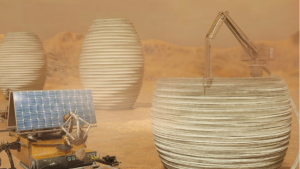This Lunar Suit Sent Musk into a Frenzy
When ancient Chinese artists painted the flying apsaras – celestial beings floating through the clouds in the Dunhuang caves – they couldn’t have imagined their ethereal ribbons would one day inspire the design of a spacesuit. Yet here we are, in 2024, as China unveils its newest marvel: a lunar spacesuit that marries the grace of traditional Chinese art with cutting-edge space technology.

China has revealed the exterior design of its next-generation lunar spacesuit, marking a significant technical milestone in the nation’s ambitious plan to land astronauts on the moon before 2030. The unveiling, which took place at the third Spacesuit Technology Forum in Chongqing on September 28, showcases the culmination of a four-year development effort that began in 2020.
The new extravehicular suit represents a substantial evolution from China’s Feitian spacesuits currently used for low Earth orbit operations. Designed specifically for lunar surface operations, the suit incorporates advanced materials science and ergonomic innovations to address the unique challenges of lunar exploration.

“Different from performing low Earth orbit missions, astronauts will be exposed to a naturally harsh lunar environment when carrying out lunar-surface extravehicular activities,” explains Wu Zhiqiang from the China Astronaut Research and Training Center. The suit must protect against multiple environmental challenges, including high vacuum conditions, extreme temperature variations, intense radiation, and abrasive lunar regolith.
A key design priority has been weight reduction while maintaining comprehensive protection. “Considering that they are working under one-sixth gravity, in order to reduce the metabolic load of the human body, it is a must to greatly reduce the suit’s weight,” notes Wang Chunhui, deputy chief designer of astronaut training systems at the Center.
Technical features of the new suit include a comprehensively protective fabric layer for thermal protection and dust mitigation, a panoramic glare-proof visor, and an integrated multi-functional control console mounted on the chest panel. The suit is also equipped with dual cameras on the helmet for both close-range and long-distance video documentation.
In demonstration footage, astronauts Zhai Zhigang and Wang Yaping – veterans of China’s space station missions – showcased the suit’s mobility capabilities, performing various movements including walking, squatting, bending, and ladder climbing. The demonstrations highlight the suit’s enhanced joint designs, which have been specifically optimized for lunar gravity conditions.

The exterior design incorporates distinctive red stripes, drawing inspiration from traditional Chinese aesthetics while serving functional purposes. The suit is part of China’s broader lunar exploration architecture, which includes development of the Long March 10 heavy-lift rocket, a new crew spacecraft, and a lunar lander.
China’s initial crewed lunar mission plan calls for a relatively brief surface stay of approximately six hours, with two astronauts conducting exploration activities. However, this mission is envisioned as a stepping stone toward more ambitious lunar presence. The country has announced plans for robotic missions to the lunar south pole in 2026 and 2028 to conduct resource surveys and in-situ resource utilization tests, leading toward the establishment of the International Lunar Research Station (ILRS) in the 2030s.
The China Manned Space Agency is currently soliciting public submissions for naming the new spacesuit, with the campaign running until October 31, 2024. This spacesuit development builds upon China’s experience with its Feitian series, which has supported 17 successful extravehicular activities during space station operations.
As China advances toward its goal of putting boots on the moon by 2030, this new spacesuit stands as a symbol of the nation’s technological prowess and cultural heritage, ready to protect the next generation of lunar explorers as they make their mark in space history.
Editor: Zhongxiaowen



